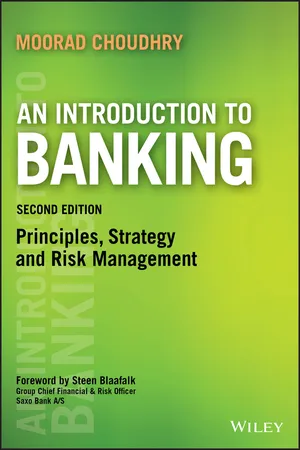
- English
- ePUB (mobile friendly)
- Available on iOS & Android
About this book
Introduction to Banking, Second Edition is a comprehensive and jargon-free guide to the banking operation. Written at the foundational level, this book provides a broad overview of banking to give you an all-around understanding that allows you to put your specialty work into context within the larger picture of your organization. With a specific focus on risk components, this second edition covers all key elements with new chapters on reputational risk, credit risk, stress testing and customer service, including an updated chapter on sustainability. Practical material includes important topics such as the yield curve, trading and hedging, asset liability management, loan origination, product marketing, reputational risk and regulatory capital.
This book gives you the context you need to understand how modern banks are run, and the key points operation at all levels.
- Learn the critical elements of a well-structured banking operation
- Examine the risk components inherent in banking
- Understand operational topics including sustainability and stress testing
- Explore service-end areas including product marketing and customer service
Banks continue to be the heart of the modern economy, despite the global financial crisis —they have however become more complex. Multiple layers and a myriad of functions contribute to the running of today's banks, and it's critical for new and aspiring bankers to understand the full breadth of the operation and where their work fits in. Introduction to Banking, Second Edition provides an accessible yet complete primer, with emphasis on the areas that have become central to sustainable banking operation.
Frequently asked questions
- Essential is ideal for learners and professionals who enjoy exploring a wide range of subjects. Access the Essential Library with 800,000+ trusted titles and best-sellers across business, personal growth, and the humanities. Includes unlimited reading time and Standard Read Aloud voice.
- Complete: Perfect for advanced learners and researchers needing full, unrestricted access. Unlock 1.4M+ books across hundreds of subjects, including academic and specialized titles. The Complete Plan also includes advanced features like Premium Read Aloud and Research Assistant.
Please note we cannot support devices running on iOS 13 and Android 7 or earlier. Learn more about using the app.
Information
PART I
Bank Business and the Markets
Chapter 1
BANK BUSINESS AND CAPITAL
THE BASIC BANK BUSINESS MODEL
- Managing the bank's capital;
- Managing the liquidity mismatch – a fundamental ingredient of banking is “maturity transformation”, the recognition that loans (assets) generally have a longer tenor than deposits (liabilities).
- Leverage: A small capital base is levered up into an asset pool that can be 10 to 30 times greater (sometimes even higher);
- The “gap”: Essentially, funding short to lend long is a function of the conventional positive‐sloping yield curve and is dictated by recognition of the asset–liability mismatch noted above;
- Liquidity: An assumption that a bank will always be able to roll over funding as it falls due;
- Risk management: An understanding of credit or default risk.
Strategy
Table of contents
- COVER
- TITLE PAGE
- TABLE OF CONTENTS
- FOREWORD
- PREFACE
- PREFACE TO THE FIRST EDITION
- ACKNOWLEDGEMENTS
- ABOUT THE AUTHOR
- PART I: Bank Business and the Markets
- PART II: Asset–Liability Management and Liquidity Risk
- PART III: Strategy, Regulatory Capital and Case Studies
- Appendix A: FINANCIAL MARKETS ARITHMETIC
- Appendix B: ABBREVIATIONS AND ACRONYMS
- INDEX
- END USER LICENSE AGREEMENT